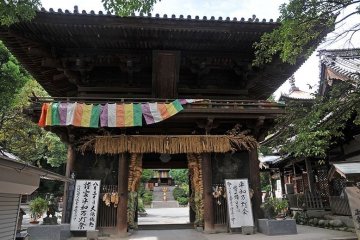
Ishiteji Temple
At Matsuyama’s most famous temple, a sight almost as guaranteed as the temple buildings themselves is the cadre of pilgrims in white traveling the Shikoku Pilgrimage, a circular 88-site, 1200-kilometer circuit. Whether you’re at Ishiteji for religious, ascetic or sightseeing reasons, the compound is sprawling and quite unusual. On both sides of Niomon Gate (a National Treasure) are two monumental straw sandals, promising relief for those suffering with painful leg conditions. As you reach the main area, you’ll be greeted by even more curiosities. Stroll through the main hall, itself lined with vibrant panel paintings, enter a cave and you reach yet another temple. This inner structure resembles a large golden bead and contains a famously eclectic collection of sculptures, carvings and paintings. Particularly arresting are the images of the skeletal historic Buddha in the period before his enlightenment. Accompanying these are countless Kannon figures, dwarves, demons and deities. Kobo Daishi, a famous Buddhist monk who supposedly originated the Shikoku Pilgrimage, is immortalized in a towering statue on a nearby forested hill. On top of its treasure-packed halls, a three-story pagoda occupies the main grounds. Ishiteji, which literally means “stone hand temple,” has an origin story as unique as its contents. A man had wronged Kobo Daishi and, wanting to atone, established the path of the Shikoku Pilgrimage in search of the monk. When they finally met, Kobo forgave him and gave him an inscribed stone with which he was buried. Then a boy was born with a stone clenched in his hand; this boy came to build Ishiteji. The legendary stone is still in a small museum on the compound, surrounded by no shortage of similarly precious relics, treasured buildings and, supposedly, people’s souls. If Ishiteji Temple proves to be sensory overload or a tiring trek, historic Dogo Onsen is a few minutes away.


/132.78898000717,33.850601516802,9/397x132?access_token=pk.eyJ1IjoiamFwYW50cmF2ZWxtYXBzIiwiYSI6ImNqbXBtOXYxbDB5Z3ozbHFrazJuYWMwOGYifQ.v15fy_mcFWtgopmz8PhwqA)

